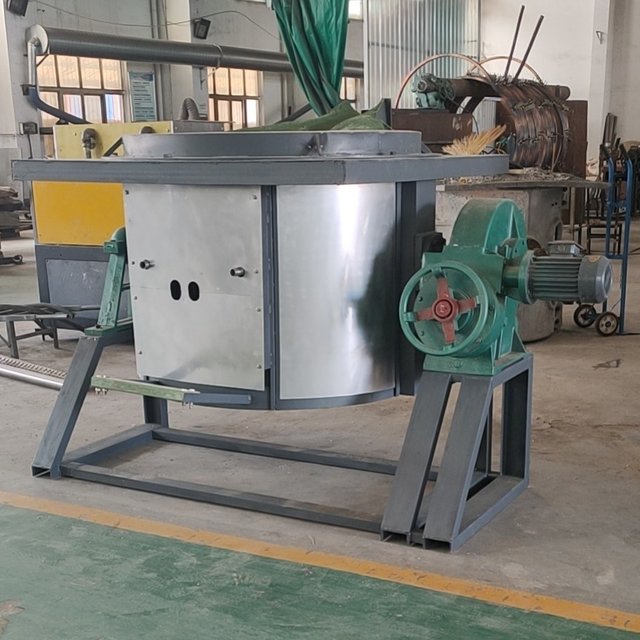Melting furnaces for aluminum
Aluminum scrap melting furnaces are designed to melt aluminum scrap and produce molten aluminum that can be cast into a variety of products. These furnaces are essential in the recycling of aluminum and the production of aluminum alloys for different applications. Here is an overview of the types, components, and processes involved in aluminum scrap melting furnaces:
There are several types of aluminum scrap melting furnaces, including reverberatory furnaces, rotary furnaces, and induction furnaces. Reverberatory furnaces use a stationary hearth and a roof that reflects heat back into the furnace, while rotary furnaces rotate to mix and melt the scrap. Induction furnaces use electromagnetic induction to generate heat within the furnace. Each type of furnace has its own advantages and disadvantages, depending on the size of the operation and the desired output.
The components of an aluminum scrap melting furnace typically include a furnace body, burners or heating elements, a refractory lining to withstand high temperatures, a charging system for adding scrap metal, and a tapping system for removing molten aluminum. The process of melting aluminum scrap involves preheating the furnace, charging the scrap metal, melting the metal at high temperatures, and pouring the molten aluminum into molds or casting machines.
Overall, aluminum scrap melting furnaces play a crucial role in the recycling and production of aluminum products. By efficiently melting scrap metal and producing high-quality molten aluminum, these furnaces help reduce waste and energy consumption in the aluminum industry. Additionally, the versatility of aluminum alloys produced from these furnaces allows for the creation of a wide range of products, from automotive parts to household appliances.
Types of Aluminum Scrap Melting Furnaces
- Reverberatory Furnaces
- Description: This furnace is horizontally designed and the heat is reflected onto the aluminum scrap through the roof and walls. It is usually used for large-scale melting operations.
Advantages: Suitable for melting large quantities of aluminum, capable of efficient refining and impurity removal.
Disadvantages: Lower thermal efficiency and more energy intensive than other types.
- Induction Furnaces
- Description: Uses electromagnetic induction to heat and melt aluminum. An induction coil generates an alternating magnetic field that induces an electric current in the aluminum, which generates heat.
Advantages: High energy efficiency, precise temperature control, and minimal contamination of the aluminum.
Disadvantages: Higher initial investment cost, suitable for small to medium-sized operations.
- Electric Arc Furnaces
Description: Heat is generated by an electric arc between electrodes. Aluminum has fewer applications than other metals, but can be used in certain situations.
Advantages: Provides high temperatures and is able to process different types of scrap.
Disadvantages: Generally more complex and costly in aluminum melting.
- Crucible Furnace
Description: A small furnace that melts aluminum in a crucible. Often used in laboratories or small-scale production.
Advantages: Simple design, suitable for small batches, low cost.
Disadvantages: Limited capacity, not suitable for large-scale operations.
Components of Aluminum Scrap Melting Furnace
- Furnace Chamber
- The main part where aluminum scrap is placed and melted. Designed to withstand the high temperatures and corrosive nature of molten aluminum.
- Heating System
- Reverberatory Furnace: Includes burners that use gas or oil to generate heat.
- Induction Furnace: Includes induction coils that create an electromagnetic field.
- Arc Furnace: Includes electrodes that create an arc.
- Insulation Material
- High temperature refractory lining designed to retain heat and increase efficiency.
- Control Systems
- Temperature sensors, controllers, and automation systems that monitor and regulate the melting process.
- Charging and Unloading Systems
- Charging: Systems that add aluminum scrap to the furnace, such as charging gates or conveyor belts.
- Unloading: Systems that remove and transfer molten aluminum to molds or other processing equipment.
- Ventilation and Fume Extraction
- Systems that manage and remove fumes, gases, and particles generated during the melting process.
Melting Process
- Scrap Preparation
- Aluminum scrap is sorted, cleaned, and sometimes crushed or preheated before being added to the furnace.
- Charging
- Prepared aluminum scrap is introduced into the furnace. In induction and electric arc furnaces, the scrap is usually loaded through a gate or charging system.
- Melting
Reverberatory furnaces: Heat from burners is reflected off the furnace walls and roof, melting the scrap.
Induction furnaces: Electromagnetic induction heats the scrap directly.
Electric arc furnaces: An electric arc between electrodes melts the aluminum.
- Refining
- Removing impurities and slag from the surface of the molten aluminum. Some furnaces are equipped with skimming or filtering systems to assist this process.
- Tapping and Casting
- The molten aluminum is tapped (taped) from the furnace and poured into molds to produce ingots, billets, or other forms.
What furnace is used for melting aluminium?
Which furnace is the best to melt scrap?
What is the melting point of aluminium scrap?
How long does it take to melt aluminum in a furnace?

"Wow, great post! 🤩 I'm loving the detailed information on aluminum scrap melting furnaces! 💡 It's fascinating to learn about the different types (Reverberatory, Induction, Electric Arc, and Crucible) and their unique advantages and disadvantages.
I'm curious, what type of furnace do you think is the most efficient for melting scrap? 🤔 And have you ever wondered how long it takes to melt aluminum in a furnace? 🔥
Let's get this conversation started! 💬 Share your thoughts, ask questions, or simply say hello! 😊 Also, don't forget to give @xpilar.witness a vote by going to https://steemitwallet.com/~witnesses. Your support will help us continue improving and growing the Steem community! 🙏"
Downvoting a post can decrease pending rewards and make it less visible. Common reasons:
Submit